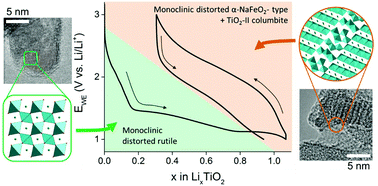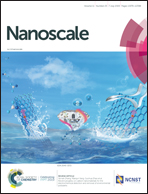Order–disorder transition in nano-rutile TiO2 anodes: a high capacity low-volume change Li-ion battery material†
Abstract
Nano-sized particles of rutile TiO2 is a promising material for cheap high-capacity anodes for Li-ion batteries. It is well-known that rutile undergoes an irreversible order–disorder transition upon deep discharge. However, in the disordered state, the LixTiO2 material retains a high reversible ion-storage capacity of >200 mA h g−1. Despite the promising properties of the material, the structural transition and evolution during the repeated battery operation has so far been studied only by diffraction-based methods, which only provide insight into the part that retains some long-range order. Here, we utilize a combination of ex situ and operando total scattering with pair distribution function analysis and transmission electron microscopy to investigate the atomic-scale structures of the disordered LixTiO2 forming upon the discharge of nano-rutile TiO2 as well as to elucidate the phase behavior in the material during the repeated charge–discharge process. Our investigation reveals that nano-rutile upon Li-intercalation transforms into a composite of ∼5 nm domains of a layered LixTiO2 α-NaFeO2-type structure with ∼1 nm LixTiO2 grain boundaries with a columbite-like structural motif. During repeated charge–discharge cycling, the structure of this composite is retained and stores Li through a complete solid–solution transition with a remarkably small volume change of only 1 vol%.



 Please wait while we load your content...
Please wait while we load your content...